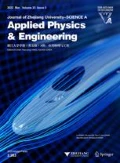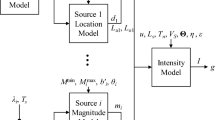Abstract
This study introduces measures to identify resonant (concentration of energy in a single or a few frequencies) or unfavorable earthquake ground motions. Probabilistic measures based on the entropy rate and the geometric properties of the power spectral density function (PSDF) of the ground acceleration are developed first. Subsequently, deterministic measures for the frequency content of the ground acceleration are also developed. These measures are then used for identifying resonance and criticality in stochastic earthquake models and 110 acceleration records measured at rock, stiff, medium and soft soil sites. The unfavorable earthquake record for a given structure is defined as the record having a narrow frequency content and dominant frequency close to the structure fundamental natural frequency. Accordingly, the measures developed in this study may provide a basis for selecting records that are capable of producing the highest structural response. Numerical verifications are provided on damage caused to structures by identified resonant records.
Similar content being viewed by others
References
Abbas, A.M., 2002. Deterministic/Reliability-based Critical Earthquake Load Models for Linear/Nonlinear Structures. PhD Thesis, Indian Institute of Science, Bangalore.
Abbas, A.M., 2006. Critical seismic load inputs for simple inelastic structures. Journal of Sound and Vibration, 296(4-5):949–967. [doi:10.1016/j.jsv.2006.03.021]
Abbas, A.M., Manohar, C.S., 2008. Investigations into critical earthquake excitations within deterministic and probabilistic frameworks. Earthquake Engineering & Structural Dynamics, 31(4):813–832. [doi:10.1002/eqe.124]
Abbas, A.M., Manohar, C.S., 2007. Reliability-based vector nonstationary random critical earthquake excitations for parametrically excited systems. Structural Safety, 29(1):32–48. [doi:10.1016/j.strusafe.2005.11.003]
Amiri, G.G., Dana, F.M., 2005. Introduction to the most suitable parameter for selection of critical earthquakes. Computers & Structures, 83(8-9):613–626. [doi:10.1016/j.compstruc.2004.10.010]
Anderson, J.C., Bertero, V.V., 1987. Uncertainties in establishing design earthquakes. Journal of Structural Engineerin, 113(8):1709–1724. [doi:10.1061/(ASCE)0733-9445(1987)113:8(1709)]
Arias, A., 1970. A Measure of Earthquake Intensity. Seismic Design of Nuclear Power Plants. MIT Press, Cambridge, MA, p.438–468.
Dhakal, R.P., Mander, J.B., Mashiko, N., 2006. Identification of critical ground motions for seismic performance assessment of structures. Earthquake Engineering & Structural Dynamics, 35(8):989–1008. [doi:10.1002/eqe.568]
Kanai, K., 1957. Semi-empirical formula for the seismic characteristics of the ground. Bulletin of Earthquake Research Institute, University of Tokyo, 35:309–325.
Kapur, J.N., 1993. Maximum Entropy Models in Science and Engineering. Wiley Eastern, New Delhi.
Lin, Y.K., 1967. Probabilistic Theory of Structural Dynamics. McGraw-Hill, NY.
Manohar, C.S., Sarkar, A., 1995Critical earthquake input power spectral density function models for engineering structures. Earthquake Engineering and Structural Dynamics, 24:1549–1566. [doi:10.1002/eqe.4290241202]
Moustafa, A., 2008. Discussion of a new approach of selecting real input ground motions for seismic design: the most unfavorable real seismic design ground motions. Earthquake Engineering and Structural Dynamics (in press). [doi:10.1002/eqe.885]
Moustafa, A., 2009. Discussion of “The effect of energy concentration of earthquake ground motions on the nonlinear response of RC structures” by H. Cao, M.I. Friswell. Soil Dynamics and Earthquake Engineering, 29(7):1181–1183. [doi:10.1016/j.soildyn.2009.02.004]
Nigam, N.C., Narayanan, S., 1994. Applications of Random Vibrations. Narosa Publishing House, New Delhi.
Papoulis, A., 1991. Probability, Random Variables and Stochastic Processes. McGraw-Hill, NY.
Park, Y.J., Ang, A.H.S., 1985. Mechanistic seismic damage model for reinforced concrete. Journal of Structural Engineering, 111(4):722–739. [doi:10.1061/(ASCE)0733-9445(1985)111:4(722)]
PEER, 2005. Pacific Earthquake Engineering Research Center. Available from: http://peer.berkeley.edu (Accessed 2008)
Shannon, C., 1948. A mathematical theory of communication. Bell System Technical Journal, 27:623–656.
Tajimi, H., 1960. A Statistical Method of Determining the Maximum Response of a Building Structure during Earthquakes. Proc. 2nd WCEE, Tokyo, 2:781–797.
Takewaki, I., 2001. Resonance and criticality measure of ground motions via probabilistic critical excitation method. Soil Dynamics and Earthquake Engineering, 21(8):645–659. [doi:10.1016/S0267-7261(01)00046-X]
Takewaki, I., 2002. Seismic critical excitation method for robust design: A review. Journal of Structural Engineering, 128(5):665–672. [doi:10.1061/(ASCE)0733-9445(2002)128:5(665)]
Takewaki, I., 2004. Bound of earthquake input energy. Journal of Structural Engineering, 130(9):1289–1297. [doi:10. 1061/(ASCE)0733-9445(2004)130:9(1289)]
Takewaki, I., 2007. Critical Excitation Methods in Earthquake Engineering. Elsevier, Amsterdam, p.1–22.
Trifunac, M.D, Brady, A.G., 1975. A study on the duration of strong earthquake ground motion. Bulletin of the Seismological Society of America, 65(3):581–626.
Uang, C.M., Bertero, V.V., 1988. Implications of Recorded Earthquake Ground Motions on Seismic Design of Building Structures. Report No. UCB/EERC-88/13, Earthquake Engineering Research Center, Berkeley, CA.
Vanmarcke, E.H., 1972. Properties of spectral moments with applications to random vibration. Journal of the Engineering Mechanics Division, 98(2):425–446.
Vanmarcke, E.H., 1976. Structural Response to Earthquakes. Lomnitz, C., Rosenbluth, E. (Eds.), Seismic Risk and Engineering Decisions. Elsevier, NY.
Zhai, C.H., Xie, L.L., 2007. A new approach of selecting real input ground motions for seismic design: The most unfavourable real seismic design ground motions. Earthquake Engineering & Structural Dynamics, 36(8): 1009–1027. [doi:10.1002/eqe.669]
Author information
Authors and Affiliations
Corresponding author
Additional information
Project (No. JSPS-P-08073) supported by the Japanese Society for the Promotion of Science
Rights and permissions
About this article
Cite this article
Moustafa, A., Takewaki, I. Use of probabilistic and deterministic measures to identify unfavorable earthquake records. J. Zhejiang Univ. Sci. A 10, 619–634 (2009). https://doi.org/10.1631/jzus.A0930001
Received:
Accepted:
Published:
Issue Date:
DOI: https://doi.org/10.1631/jzus.A0930001
Key words
- Entropy rate
- Dispersion index
- Power spectral density function (PSDF)
- Frequency content
- Unfavorable ground motion
- Resonant acceleration
- Critical accelerogram
- Energy
- Damage index




